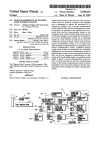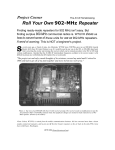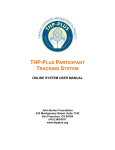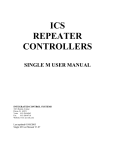Download GE Mastr II - Spokane Repeater Group
Transcript
GE Mastr II Station interfacing for link use:
By Karl Shoemaker, Jan 2014
Introduction:
This document is written to include interested people in serious construction of a quality product. Its rather
technical, however, if you have a basic electronics background with some repeater building experience
this should not be an issue. Some of it’s dry reading however, you need to spend time on this to better
understand advanced circuits, later on. Understanding schematic drawings is required. If you are new at
the repeater operation you might want to seek experienced help. Allow plenty of time to construct each
radio, especially the first one. No free technical support is available however, some printed documents
are available on an occasional bases, for a modest cost for P & H. The project is designed for Amateur
Radio (not commercial) and is open for discussing, changes and improvements without notice. Should
you feel qualified you are welcome to deviate from the Author's design. Images in this document may be
used to illustrate a point only and may have been taken at different stages of research and development
therefore, may not show the end “product” in some cases.
Overview:
For this project the GE Mastr II Station in the amateur 2-meter band is used. This project is an access
repeater for Spokane Repeater Group users. This equipment works in the "foreground" for providing local
coverage for the users to enjoy. It’s interfaced with external linking equipment for positive and full-time
connection with the rest of the K7SRG system. From OEM specifications, no performance or reliability
degradation was observed from the modifications discussed in this document.
Acronyms, Definitions, semantics and Theory basics:
To be very clear on this philosophy, we will start with very basic theory. Radio systems send intelligence
(voice, data, etc.) by modulating the originating transmitter and decoding (detecting) this modulation at
the far end receiver back to something usable to be understood. How well this is understood depends
greatly on how well the system is set up. Just about anyone can "throw" a system together to make it
work, somewhat.
Amateur radio can develop the art of radio and improving operating practices in this area. This can set a
good example for others, including the commercial industry, to what some amateur radio systems are
capable of doing and to provide public service communications in time of need. This includes the
technical side, to produce a high performance repeater or link.
A typical (commercial) system uses the audio portion of 300Hz~3KHz for signals. This document covering
system performance will be somewhat different. It also calls for good technical management. For one,
technician organization and discipline is necessary. Plan on what you want to do for a system design and
stick to it. Force yourself to keep good practices. One good practice is to establish level references. Some
call these "benchmarks" or "baselines". While old methods used linear (microvolts, watts, etc) units of
measure, most SRG designs and operations use logarithmic units in "dbm". Once accustomed, it's easier
to see the entire picture this way, when designing a system or checking system performance and keeps
the guesswork out of troubleshooting a subtle level problem.
Most radio systems in the VHF, UHF (and microwave) are line-of-site for the radio paths. On the ground a
path has limited range. From high (remote) sites greatly increase this. A “repeater” is a generic term for
user’s signals to be received (input) and retransmitted (output). This greatly increases radio coverage,
especially at high locations. A “link” is a one-way transport method for support of such a repeater. For
example, a repeater’s (input) receiver may need to be “downlinked” to a central control point, such as a
voter or connection to the outside world (telephone, internet, etc.). From this control point the system
output can be “uplinked” back up to a high transmitter (output) for the users to enjoy wide coverage of
such a system. In this case would be a multiple site repeater (system of links, etc.) SRG design
specifications call for a better way, as you will see in this documentation.
1
References can be expressed in a few acronyms. Normally, a tone of 1 KHz (sometimes 1004 Hz) is
used for a testing a "2-way" VHF-UHF transmitter or receiver. TTL ( Test Tone Level ) is referenced to
100% system modulation; in this case F.M. (Frequency Modulation). FM is also referred to "deviation" (of
the carrier, at an audio rate). For amateur radio 100% system modulation is normally + - 5 KHz. Other
areas/States and/or commercial services have different bandwidth standards such as +- 2.5 KHz. For this
documentation we will only cover the former (5 KHz deviation).
TLP ( Test Level Point ) refers to a measurement point (normally on equipment) in reference to TTL. TLP
provides easy reference to any parts of the system for measurement and alignment. 0 dbm is referenced
to 1 milliwatt at 600 ohms. Therefore, a transmitter AF input with a TLP of 0 dbm, with a TTL of 0 dbm
tone input, would fully modulate the system. If the far end receiver was set up the same its output a 0
dbm tone as well. A 6-dB drop in (voltage) level would reduce the modulation in half, and so on. In
general, levels are stated in transmit-receive (Tx-Rx) order. Therefore, an audio (VF) "drop" TLP of 0/0
would mean a Tx TLP of 0dbm, Rx TLP of 0dbm. Absolute levels are specific-measured (operating)
levels, not to be confused with TTLs.
Sometimes operating levels are not at TTL. In this case a level would be so many dB "down" from TTL, or
just called "xx down". For example, CTCSS (sub-audible) tones normally are 18 dB down. (1/8 deviation
from voice, or 18 dB down from max-voice and/or TTL). To avoid technician confusion two sets of
numbers are sometime used in diagrams and on the physical equipment's ports or I/O connections.
Figures in parenthesis are the TLPs. Non-parenthesis figures are (absolute/actual) operating levels, and
as mentioned before, may be at different levels from the TTLs.
Levels below 0 dbm are negative, while above are positive. Take this into consideration when working
with system gains or losses. Normally the negative levels have a minus in front of the number, while
positive have a plus sign. This is also true for absolute levels (as opposed to TTLs). For example, most
transmitters run a +42 dbm while most receiver's sensitivity run a -117 dbm for 20 dB quieting, as in the
case of the radio being modified for this project. These levels are at the transmit and receiver ports,
respectively. Also known as "TOR" (Top Of Radio), AKA, Top of Rack is before the transmission line and
antenna outside on the tower. The latter parts can be figured in for the entire system's losses or gains.
Single digit numbers of "1" and "0" in parenthesis or brackets “[ ]”, are not to be confused with TLPs. In
this case these 1s and 0s identify the logic state of a gate, or other TTL/CMOS I/O driver circuit, and so
forth. Another aid to avoid confusion between logic states and a TLP is that the latter normally would have
a " + " or " - " before the number. For example, a TLP of -14.8 is the audio input controlled by a logic gate
of [1], being a normal logic "high". One last word on the logic state. The parenthesis indicates a state in
normal standby/no activity condition. As a side note, "TTL" mentioned above has nothing to do with "TTL
logic", a type of IC series.
The term "PTT" ( Push To Talk ) came from a button on a radio’s microphone. For this documentation
PTT will describe an active going "low" for DC functions, such as transmitter keying ("PTT Input"). It also
will describe a receiver's COR line driving a NPN transistor, with the open collector being "Receiver PTT
Out", or just "PTT Out". "PTT 1" will describe this function however, with a buffer, such as the output of
the COR/AF board, which changes state for user signal change of status. This function would be used for
audio switching, such as Auto-Patch audio routing. "PTT 2" will describe a buffered, and “hangtime/tail”
output of the COR/AF board, to keep a repeater's transmitter keyed up (AKA tail) for normal back-andforth conversations of the users of such system(s). One or both types of PTTs may be time-out controlled.
The term "COR" came from the old tube days of "Carrier Operated Relay" whereas, a tube receiver had a
point, when its squelch opened, a tube (switch/valve) drew current through a relay's coil, to give some
contact closure, to key the associated repeater's transmitter. As the solid state technology came in the
later 1960's the term stayed with repeater operation, even though the Author saw no "relay" in most
modern repeaters and felt the "relay" term should have been replaced with the term of "squelch", since it's
the receiver's squelch that does the signaling. This would be called" COS", meaning a "Carrier Operated
Squelch".
Both terms are correct and this gets down to semantics or content of a discussion. After careful
consideration of modern technology used in the LMR field by amateurs and professional alike, including
recent repeater product terminology and to the fact that repeater stations in the early years were also
called "Relays", whereas, the station would "relay" a signal rather than "repeat" a signal, the Author
2
decided to stay with the majority's term of "COR", to avoid reader confusion. Therefore, this and other
SRG documentation will reflect this decision.
"COS" may also be used to describe a "Carrier Squelch" as a part of a receiver. "CS" will be reserved to
describe "Carrier Squelch" as a receiver's mode of operation, verses "TS", "PL" or "CTCSS" to describe a
"Tone Squelch", "Private Line" or "Continuous Tone Coded Squelch System", respectively.
"PLI" means Private Line Indicator (or Input). It's also similar to a CTCSS line out of a tone decoder.
"HUB" means Hang Up Box. Motorola's uses a "closed loop" and a HUB for mobiles and base station
control. "AND squelch" means it takes both carrier + tone to activate a COR board, transmitter or system.
AND squelch is also referred as a variable sensitivity squelch whereas, the squelch setting affects activity
threshold. An "OR" squelch does not, whereas, it "bypasses" whatever squelch setting, using only tone to
keep it active. More is discussed, later in this document.
Other definitions, acronyms and other "shortcuts" are for practical reading and document space. For
example, names are truncated only after the full name is established. This avoids misunderstandings.
For example, the parts list shows several manufacturers in truncated form. For example, Mouser
Electronics (a major parts supplier) is later referred to as "Mouser".
FM:
Frequency modulation is the common way to send intelligence in the LMR analog world. There are two
ways to frequency modulate a transmitter; PM and FM. Phase modulation is the easiest design with good
frequency stability however, lacks audio response. However, PM has “natural” pre-emphasis which works
well for LMR standard. On the other hand, FM has much better response (flat audio) at the cost of more
complex engineering to keep stability. With synthesized/PLL transmitters this is major consideration. This
point comes to home with the equipment this document is about. However, later technology in design has
allowed FM to perform well in LMR systems. It’s also referred to as “direct FM”. With careful design
changes, FM can perform well and is the method used for all SRG equipment.
A quartz crystal is normally used to control the frequency of an oscillator. A capacitor across the crystal
can fine-adjust the frequency in the form of “warping” it. Transistors and diodes as such, all have P-N
junction inside the case. The junction has a “space” in the middle in the form of capacitance called the
“depletion zone”. By applying reverse voltage in the form of “bias” will affect the zone. More reverse
voltage results in more space, causing less capacitance. In a RF circuit this can mean higher frequency.
By applying (and changing) reverse voltage (bias) across the diode will change its capacitance causing a
change with the oscillator’s frequency at the same rate. By applying “intelligence” in the form of audio
(acv/voice) on top of the bias will cause the RF circuit to change in frequency at the same rate, thus
creating (direct) FM. There’s a range the diode will work in, causing a linear frequency change from the
voltage change on the diode. Therefore, careful design is necessary to create good symmetry (waveform)
on a frequency modulated RF carrier.
Most PM transmitters have the diode in series with the crystal causing a phase difference from the
fundament frequency, while most FM transmitters has the diode in parallel to the crystal. For FM
transmitters, most have the anode to (common) ground and usually across the crystal.
Modulation and Deviation are the same results when talking about FM. Deviation of 5 KHz means 5 KHz
above the center frequency and 5 KHZ below the center frequency, making a total bandwidth of 10 KHz.
There is other “energy” in the form of sideboards, which won’t be covered in this document.
When modulating an oscillator, the fundamental crystal frequency then will be converted by multiplying its
frequency to obtain the (final) operating frequency. For example, a typical LMR VHF transmitter would be
12 times; or a tripler, driving another doubler, driving a final doubler. (Fc=12 MHz x 3 x 2 x 2 =144 MHz).
Frequency multiplication also multiples the modulation of the fundamental. Since this arraignment
multiples the crystal frequency 12 times it won’t take much capacitance change to obtain 5 KHz
modulation (deviation) at the operating frequency. The diodes come in various specs, for capacitor range.
Typical is 10 ~ 13 pf for LMR.
3
The radio:
The GE Mastr II Station is housed in chassis
taking up 7 RUs. The transmitter-Receiver
(drawer/door unit) is in a separate box with 3 I/O
connectors, plus the two RF ports. It duplexes just
fine even with the top cover removed (for
maintenance).
Two types of transmitter-exciters were produced;
the old type, using a conventional crystal inside a
plug-in module called an ICOM. The transmitter
tuned stages were multipliers and amplifiers.
The newer type was a PLL for frequency control.
The (voltage controlled) oscillator is capable of
anywhere in the design frequency band, in this
case 136 ~ 174 MHz. It “sees” the ICOM’s LO
and locks on to it in a very short time. This type
requires only one tuning adjustment which is the
VCO’s range (coil). The nominal RF output is +23
dbm. This drives the external RF PA.
GE does their voltage distribution slightly different over Motorola’s “Compa Station”. The stations’ power
supply is a rough 15v semi-regulated only to the point of the ferro-resonant AC transformer. The rough 15
volts is routed to two places, the PA and the control shelf’s 10v-regulator/control card. That card also
controls the transmitter’s PTT and audio.
The exciter control is simple. Most of its circuits are “hot”. The control card on the control shelf inputs (low
going) PTT and outputs keyed 10v that goes to the exciter’s P902-12 to key the station. This makes the
system amateur “friendly” and easy to troubleshoot (Motorola’s way is rather complicated for the compa).
The receiver is conventional, with an ICOM-LO, mixer and front-end tuned stages. When bringing the unit
out of commercial service you have to carefully tune its stages. You may need the OEM service manual
and test set to do this effectively since the receiver is very selective. Just cramming a high level signal in
the RF port for tuning won’t do in this case.
The receiver’s boards are interfaced with what GE calls the “system board”, not to be confused with the
control shelf’s’ back plan board (that Moto calls theirs) which GE calls the “motherboard”.
Interfacing:
Being the repeater is on a single
frequency, other “F” select lines may be
used for other functions in this project.
The rear connections on the mother
board will be used for I/O to external
equipment. In most cases that will be
P1 and P2 on the rear. They use the
large “molex” type pins. Therefore,
additional wires running around the
chassis will be avoided for a “clean”
installation.
The GE does have a high challenge to
make it (flat) direct FM, while the
receiver is easier with a few jumpers needed only. Starting with the transmitter, the ICOM has two inputs,
the (stock) PM (phase modulation) audio with a varactor diode in series from the crystal to the oscillator
4
on pin 3. The other input is a second veractor diode paralleled across the crystal. In stock form it’s used
as a (DC) temp compensation for temperature changes on pin 4. The latter will be used for direct FM.
Most SRG stations are located at a temperature controlled site, so compensation is not a major concern,
especially if you add the appropriate temperature compensation capacitor to keep the crystal on
frequency within the .002 PPM spec. (that’s .0002 %) However, there are reputable people that will differ
with this method, so take this into consideration for your own project.
To get started, open up the ICOM. There’s a screw on the top of the can, typically a torx 5 head. Then pry
out the two tabs on the bottom edge of the can to pull it out. The PCB has several components including
the (fundamental) oscillator, crystal, modulation and stability circuits. There are two methods to modify the
ICOM for direct FM.
The first method keeps the PM (and mic) functional at the cost of the FM not a perfect waveform. The
second produces a good FM waveform however, disables all the PM circuits including the local mic.
For the first, referring the diagram below, replace the varactor diode (used for comp) with a Motorola
MV2104 type or equivalent. Capacitance should be in the 10 pf range. You may have to experiment with
the proper capacitance swing with different diodes.
When using the MV the Author experienced an
issue with netting the crystal on frequency.
There appeared too much capacitance from the
diode to the first coupling capacitor. This is
normally a (brown) silver-mica therefore, should
be easy to locate. By change it from 30 pf to
22pf improved netting range. The symmetry was
acceptable, however the TLP was too high (>
+10),
The capacitor on the comp line input will affect
the top end’s response therefore, change it from
.001 uf to 100 pf * (its for RF filtering). Also,
change out the first 56K resistor with a 1K to
improve (lower) the TLP.
Bias the new varactor diode with a voltage divider, using a 10K trim pot that you can solder directly on
some unused ICOM pins on the exciter board. The picture shows position 6 was used in this case. It’s
anticipated the station never would be used for muli-frequency operation and this area allowed easy
access for modifications and adjustments. The top of the pot goes to 10v on pin 1, the bottom to ground
on pin 5 and the wiper is the bias on pin 4 of the ICOM, which feeds the diode with the bias. Remember,
the pin 4 is the old comp line which goes to all the ICOM positions, F1~F8. In order to connect this line to
an interface point, install a jumper from pin 4 to pin 9 on slot 4, which is the Tx F4 select line, ending up
on the rear plug J2-8; which is another nice point for external equipment.
* Up to 180-pf substitute value is acceptable.
5
Starting with 3v bias, then key the
transmitter and tuned for best
symmetry observed on a service
monitor’s scope. It will be
important to select the proper
diode for a balance between good
symmetry and frequency warping
range. The response should easily
make 10Hz ~ 8 KHz. This will allow
you to use the transmitter for any
amateur configuration.
The second method is similar with
a few exceptions. Referring to the
diagram on the left, leave the
original (comp) diode in place. This
will be the primary (and only)
(direct) modulation device. Then
remove the PM diode and replace
it with a 15 pf capacitor. This
greatly improves the netting range and lowers the TLP to a usable level of around a +3dbm. Remember,
the local mic and other internal audio paths will no longer function. For repeater use the Author felt this
was not a major issue. This method also uses a different way for installing the bias voltage.
A “cleaner” looking bias circuit was designed. If you
have a spare ICOM for parts, strip the necessary
components off it to isolate pins 1, 4 and 5. The Author
choose to remove all components for display and
research reasons. Next, install a 10K trim pot. 10 or 20
turn type is best. The holes used that line up with the
pots’ leads put it in a great spot for a tool to access
through the top of the can, when completed. You also
will need two jumpers on the ICOMs board; pin 1 to
the top of pot (10v) and pin 4 to the wiper. The low
side of the pot goes to ground. One (minor) twist; the
adjustment will be reversed; CCW to increase the bias
voltage. We will now call this the “bias ICOM”.
6
The Author was concerned about the PCB pins touching the can. Using a piece of laminate plastic
prevents this. Make a notch for the rivet area.
Assemble the bias ICOM and install it in any position other than the channel’s ICOM (which would be F1).
In the picture the bias ICOM is in the F8 slot.
Inject a test tone to deviate the transmitter fully; in the amateur world is 5 KHz. Tune the bias for best
symmetry. You will have to reset the input test tone to verify its good at TTL. Typical bias will be 2.8~3.0
volts, positive. For this test the Author adjusted it for 2.867. Using the bias ICOM is “cleaner” in
appearance over the first method tried, which was soldering a trim pot directly to the pins of a position (6)
as you can see in the picture.
Receiver:
The receiver is easier. For start, the audio will be picked off the discriminator of U602. There are active
components (such as Q601) to bring the level up however, complicates maintenance. For example,
adjusting R608 would change the TLP. To simplify, the “FM DET MTR” audio is used, which is from the
discriminator, going through a few connections then appearing on P904-3. From pin 3 there’s no outside
connection from this point, so a jumper was installed from the IF/audio board’s P904-3 to the oscillatormultiplier board’s P903-3 (old Rx F3 select line). From this point it goes out the (old) F3 Rx line and ends
up at J2-3 on the back of the chassis. The Rx F3 line is not planned to be used, plus there appears no
components on this line to affect the audio, making this an ideal circuit for audio output.
The (stock) TLP for this point was found to be too low (around –25) therefore, R607 value is change from
the 180K to 1K. This brings the TLP up to a (typical) –16 which the (external) cor/af board can handle
this level (see separate document on that device).
7
Next, the receiver’s cor (signaling) can be obtained from the (stock) CAS from U603 that appears on
P904-9 and ends up at J1-13 on the back of the chassis. Using unused lines is a “cleaner” way instead of
the audio and cor wires running through the chassis.
The picture shows the bottom of the system board and the receiver boards with the shields in place. .
Remove the bottom shield gain access to the points to jumper. A close-up of that jumper shows from the
discriminator point. One nice feature (over the Moto) is the little shields are not soldered to the board,
making removal a snap.
8
The OEM manual shows most of the connection lines between various components of the station, such
as the system board, motherboard, etc. You will need to do a lot of back-and –forth tracing since these
lines appear on several pages of the manual. The Author provided a simplified block and level set of
diagrams that are supplements to this document. It greatly clarifies the circuits to someone just starting
out understanding this radio.
For the controls there are two thought-plan processes.
•
Conventional, stand alone repeater with linking. This would be the configuration most amateur
repeaters are set up, with its receiver audio & PTT going into a controller (on site) and it’s output
going to the transmitter as well, including any IDer audio. This would be a single-site station, with
possible linking into another repeater, group or service.
•
SRG, 4-wire drop-in station, with linking. This is the normal configuration for SRG, with its receiver
audio & PTT downlinked to another station, typically a (distant) hub repeater or MCP. The return
audio & PTT from that hub or MCP uplink. Therefore, the 2-meter station is not stand-alone; the path
goes through the distance end. This also supports multiple sites, whereas only a receiver is at one
site, while the associated transmitter is at another. In either arraignment the distance hub or MCP
controls the audio, PTT and other functions, such as the IDer. Because of this it’s optional to have
the repeaters IDer either on the GE control shelf, feeding the local (PM) mic audio or located inside
the linking package and feeding the same (FM) audio as the link’s audio.
Other notes:
When using the CG decoder board (plugged into the system board) the output mutes the local speaker.
It’s better to be able to monitor on carrier squelch, yet have the receiver’s PTT out (cor) on tone “AND”
squelch. To do this leave the jumper H41-H42 on the system board, out.
When checking receiver desense and want to use the local PTT (mic or slide switch) which will mute the
receiver. It’s best to have the receiver running (for full-duplex) all the time (on any PTT line active). To do
this leave the jumper to H18 out and install the jumper from H20-H19 on the 10v reg/control card on the
control shelf. H2-H4 was optionally left in at the time of research on this issue.
Speaking of the control card, one improvement is to replace both slide switches with toggles. Make the
one PTT enable-disable and the other a PTT lock on switch, for testing. The supplement document
drawing shows the connections.
This may be copied in complete form only for non-profit purposes, such as for the knowledge for the
Amateur Radio Service, with AK2O credited as designer. For other arrangements please contact the
Author.
Copyright: AK2O 2006, updated 1-21-2014
9


















